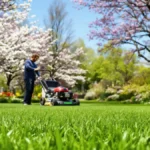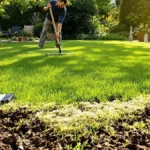Maintaining a vibrant garden requires an understanding of the seasonal needs of plants and the delicate balance of nature. By utilizing effective landscape maintenance strategies, any garden can thrive and become a sanctuary of color and life throughout the year. This guide provides essential tips for nurturing a beautiful and sustainable outdoor space. From preparing gardens for seasonal changes to implementing eco-friendly practices, there are countless ways to enhance the beauty of any landscape.
Summary:
- Year-Round Landscaping Essentials
- Sustainable Gardening Practices
- Seasonal Maintenance Tips
- Pruning Techniques for Healthy Plants
- Attracting Beneficial Wildlife
Year-Round Landscaping Essentials
A flourishing garden is the result of consistent care and attention throughout the seasons. Essential maintenance tasks include:
- Regular watering 💧
- Soil testing and enrichment 🌱
- Planting seasonal flowers and herbs 🌸
For robust landscape health, embracing tools from reliable brands such as Miracle-Gro and Scotts can significantly improve soil fertility and plant growth.
| Maintenance Task | Best Tools |
|---|---|
| Soil Testing | Bosch Garden Soil Test Kit |
| Weeding | Greenworks Electric Weeder |
| Lawn Care | John Deere Lawn Mower |

Sustainable Gardening Practices
In today’s world, eco-friendly practices are crucial for a sustainable garden. Techniques like composting and using organic fertilizers are not just beneficial for plants but also for the environment.
- Composting kitchen scraps ♻️
- Utilizing organic mulches 🌾
- Encouraging natural pest control methods 🐞
With brands like Black & Decker providing efficient garden tools, the journey toward a sustainable garden can be both rewarding and straightforward.
Seasonal Maintenance Tips
Each season brings unique challenges and opportunities for the garden. Adapting to these changes is vital to success:
Spring: Preparation for Growth
Spring is a time of renewal. Important tasks include:
- Clearing debris and preparing beds 🌼
- Planting new perennials and annuals 🌻
- Applying fertilizers for nourishment 🍂
Summer: Watering and Pest Management
In the heat of summer, focus on:
- Deep, infrequent watering for strong roots ☀️
- Using companion plants for pest control 🌸
Utilizing irrigation systems like those from Husqvarna can simplify summer maintenance.
Fall: Cleanup and Soil Enrichment
As gardens prepare for winter, essential fall tasks include:
- Removing spent plants and debris 🍁
- Adding organic mulch for winter protection ❄️
Winter: Protection and Pruning
Winter may seem quiet, but critical maintenance persists:
- Mulching to insulate roots 🌿
- Pruning dead or diseased branches ✂️
Pathways and patios: Enhancing your landscape with functional features
Pruning Techniques for Healthy Plants
Pruning is essential for plant health. Effective methods include:
- Timing cuts correctly for optimal growth ⏰
- Using sharp, clean tools to prevent disease 🛠️
Including brands like Echo can help ensure the right tools are used for maintenance, boosting garden vitality.
| Pruning Technique | Optimal Season | Recommended Tool |
|---|---|---|
| Deadheading | Spring/Summer | Gardena Pruning Shears |
| Structural Pruning | Winter | ECHO Chainsaw |
Attracting Beneficial Wildlife
Creating a habitat that supports wildlife enriches the garden ecosystem. Essential strategies include:
- Integrating plants that offer food and shelter for pollinators 🐝
- Using birdhouses and feeders to encourage local fauna 🐦
- Creating water sources for wildlife like small ponds or bird baths 💧
Implementing these thoughtful practices can create a harmonious environment where plants and wildlife thrive together.
FAQ
- What is the best time to prune my plants?
The best time to prune most plants is during their dormant season, typically late winter or early spring. - How often should I water my garden?
To promote healthy root systems, gardens should be watered deeply and infrequently, ideally once a week, depending on rainfall. - What are the benefits of using organic fertilizers?
Organic fertilizers improve soil health, reduce chemical runoff, and promote biodiversity in the garden.
















